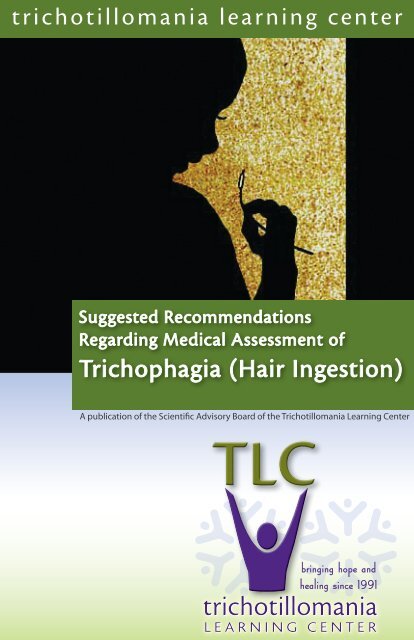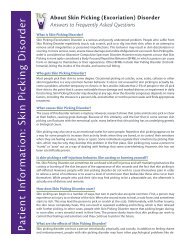Trichophagia (Hair Ingestion) - the Trichotillomania Learning Center
Trichophagia (Hair Ingestion) - the Trichotillomania Learning Center
Trichophagia (Hair Ingestion) - the Trichotillomania Learning Center
- No tags were found...
You also want an ePaper? Increase the reach of your titles
YUMPU automatically turns print PDFs into web optimized ePapers that Google loves.
The <strong>Trichotillomania</strong> <strong>Learning</strong> <strong>Center</strong> (TLC) is a non-profit organizationdevoted to ending <strong>the</strong> suffering caused by hair pulling disorder, skin pickingdisorder, and related body-focused repetitive behaviors (BFRBs).TLC is advised by a Scientific Advisory Board comprised of leading researchersand clinicians in this field.AuthorsThis pamphlet is a project of <strong>the</strong><strong>Trichotillomania</strong> <strong>Learning</strong> <strong>Center</strong>’s Scientific Advisory Board.Contributing Authors:Jon E. Grant, JD, MD, MPHJoseph Garner, PhDRuth Golomb, LCPCSuzanne Mouton-Odum, PhDCarol Novak, MDChristina PearsonJennifer Raikes© 2011 <strong>Trichotillomania</strong> <strong>Learning</strong> <strong>Center</strong>, Inc. All Rights Reserved.The information in this booklet is not intended to provide treatment for<strong>Trichotillomania</strong> or <strong>Trichophagia</strong>. Appropriate treatment and advice shouldbe obtained directly from a qualified and experienced doctor and/or mentalhealth professional.TLC is a 501(c)(3) tax-exempt organization and all contributions are taxdeductible. Our Tax ID number is: 77-0266587.2
Advice for Families<strong>Hair</strong> pulling (trichotillomania) is a problem which is typically described as <strong>the</strong>pulling of hair resulting in hair loss. In addition, <strong>the</strong> hair pulling is usuallydisruptive to some daily functioning of <strong>the</strong> individual; however, hair pullingin children can be quite different in that <strong>the</strong> child may not experience anydistress about <strong>the</strong> behavior or hair loss. In a small number of cases, <strong>the</strong> childmay eat or swallow <strong>the</strong> hair. In this circumstance, <strong>the</strong> behavior may cause aserious medical condition that must be evaluated by a doctor.Every child who pulls hair does not swallow it. However, a minority (5%-20%)of those who pull also eat <strong>the</strong> hair. This can result in an intestinal blockagethat can be extremely serious, even life threatening. For this reason, we haveexamined <strong>the</strong> literature and studied <strong>the</strong> experiences of expert clinicians inorder to develop <strong>the</strong> following recommendations.Some common symptoms (though not always present) are: stomach pains,periodic vomiting, constipation, bad breath, and very slow or no growth. Ifyour child is pulling and swallowing hair, your child should be examined bya pediatrician or family doctor. Ask your doctor for BOTH bloodwork andimaging to determine if a blockage is present. During this exam, <strong>the</strong> doctorshould be checking <strong>the</strong> abdomen for a mass, commonly thought of as a hairball.Upon completion of <strong>the</strong> first exam, <strong>the</strong> next step would be to run somelab tests, and <strong>the</strong>n to perform an image test in order to see if a blockage existsand, if so, where it is and how large it may be. The image tests include: CTscan, X-ray, endoscopy, ultrasound, or Barium swallow.If your child has had an intestinal blockage, <strong>the</strong>n your child should have animaging exam (X-ray, CT scan, or ultrasound) twice each year to make surethat no fur<strong>the</strong>r blockage occurs. If your child is no longer pulling hair, afterone year of follow up, you may discontinue imaging exams.Many, if not, most children can be quite embarrassed about <strong>the</strong>ir behaviorand <strong>the</strong>refore may not be truthful if asked about swallowing <strong>the</strong>ir hair. If you,as a family member, suspect that your child is swallowing his/her hair, <strong>the</strong>n<strong>the</strong> child should be seen by a doctor to rule out <strong>the</strong> presence of an intestinalblockage. In addition, it is important to note that most children often do notlike going to <strong>the</strong> doctor (no matter how nice <strong>the</strong> person is!) In addition, <strong>the</strong>idea of lab work or any kind of test may be scary to a child. Therefore, this isnot <strong>the</strong> child’s decision, it is <strong>the</strong> parent’s decision.Please discuss <strong>the</strong> exam and procedures with your child’s physician and feelfree to provide him/her with <strong>the</strong> information from this article, found underAdvice for Professionals.3
Advice for Professionals<strong>Hair</strong> pulling disorder (trichotillomania) is a disorder characterized by <strong>the</strong> noncosmeticpulling of hair, resulting in significant hair loss. It has beena recognized medical problem since Hallopeau’s description in 1889, 1 but itwas actually trichophagia, <strong>the</strong> eating of hair, which first captured <strong>the</strong> attentionof medical texts. In <strong>the</strong> late 18th century, <strong>the</strong> French physician, Baudamant,described a trichobezoar in a 16-year-old boy. 2 Even with this long history inmedical literature, trichophagia has received little medical attention except asa rare symptom of trichotillomania.<strong>Trichotillomania</strong> is often characterized by repetitive rituals performed withhairs after <strong>the</strong>y are pulled. These rituals include biting on <strong>the</strong> hair, chewing it,playing with it and even swallowing it. Swallowing of <strong>the</strong> hair is <strong>the</strong> mostphysically hazardous of <strong>the</strong> behaviors as it can result in a trichobezoar (hairball) which can block <strong>the</strong> intestinal tract and, if left untreated, can be a lifethreateningemergency requiring surgery. Research suggests thatapproximately 5%-20% of individuals with trichotillomania engage in episodicor frequent trichophagia. 3, 4 Trichobezoars appear to be more common inindividuals under <strong>the</strong> age of 30 years . 5Clinicians should be aware that children and adults with this behavior may bedeeply embarrassed about both <strong>the</strong> pulling of hair and particularly <strong>the</strong> ingestionof hair. Questions regarding <strong>the</strong> behavior should <strong>the</strong>refore be asked in anempa<strong>the</strong>tic and nonjudgmental fashion.Symptoms associated with trichobezoarsAlthough many people with trichophagia and trichobezoars may have nosymptoms until <strong>the</strong> problem becomes quite severe, <strong>the</strong> literature does providesome limited clues as to what patients, physicians, and family members may6, 7, 8, 9see as warning signs of a more severe health problem.These symptoms may occur singly, in any combination, or not at all.1. Abdominal or epigastric pain2. Faintness and dizziness3. Fatigue4. Chest discomfort5. Change in stool color to dark green-to-black color(i.e. gastrointestinal bleeding)6. Vomiting7. Nausea8. Weight loss9. Loss of appetite10. Diarrhea or constipation4
RecommendationsThe question of when trichophagia requires immediate medical attentionis unfortunately unclear. Many people with trichophagia do not developtrichobezoars. Those who do, however, are potentially at risk of severecomplications or even death. Based on <strong>the</strong> available literature, we <strong>the</strong>reforerecommend a standard of investigation for anyone eating <strong>the</strong>ir hair, butparticularly those who present with any of <strong>the</strong> above symptoms.What should a medical assessment consist of?1. Clinical evaluation of hair pulling and nail biting and whe<strong>the</strong>r andto what extent ingestion of hair and nails occurs. This should beperformed by someone trained in <strong>the</strong> assessment of trichotillomaniaand o<strong>the</strong>r body-focused repetitive behaviors.2. Abdominal examination – particularly to check for left upper quadrant mass3. Laboratories – person may present with anemia4. Radiological assessment4a. Abdominal X-ray – generally not useful except to confirm an obstruction4b. Abdominal CT scan – diagnostic in 97% of trichobezoar cases4c. Upper gastrointestinal endoscopy4d. Barium swallow – maximum benefit in small bowel to differentiateobstruction due to adhesions from obstruction due to bezoars4e. UltrasonagraphyAlthough all of <strong>the</strong>se radiological modalities have been used successfully todiagnose a trichobezoar, in some cases, <strong>the</strong> most reliable means of detectinga trichobezoar appears to be an abdominal CT scan.Therefore, we recommend that when any of <strong>the</strong> above list of physical symptomsis present in a person who ingests hair, an abdominal CT should be performed.When a person who ingests hair presents with no symptoms of intestinalobstruction, a thorough mental health assessment and physical examinationare required. Radiographic evaluation may be necessary depending upon <strong>the</strong>physical findings.In cases where someone has had a trichobezoar in <strong>the</strong> past, we agree with <strong>the</strong>clinicians who suggest bi-annual abdominal imaging to evaluate for recurrenceof a trichobezoar. 10Treatment of trichobezoarsThe treatment of trichobezoars depends upon size and location. Upper endoscopyhas been used to remove trichobezoars but its success rate has been reported atonly about 5%. 11 Surgery, is usually needed to remove large trichobezoars or whenintestinal obstruction results. It has had a success rate of 99%. 115
References1. Hallopeau, M. Alopicie par grattage (trichomanie ou trichotillomanie). Ann DermatolVenereol 1889;10:440-441.2. Baudaman,t M. Description de deux masses de cheveux trouvee dans l’estomac et lesintestines d’un jeune garcon age de seize ans. Hist Soc Roy Med, Paris 1777-1779;2:262-263.3. Christenson, GA, Mackenzie, TB, Mitchell, JE. Characteristics of 60 adult chronic hairpullers. Am J Psychiatry 1991b; 148(3):365-370.4. Grant, JE, Odlaug, BL. Clinical characteristics of trichotillomania with trichophagia.Compr Psychiatry 2008; 49:579-584.5. DeBakey M, Ochsner, A. Bezoars and concretions: comprehensive review of literaturewith analysis of 303 collected cases and presentation of 8 additional cases. Surgery1939; 5:132-160.6. McGehee, FT Jr, Buchanan, GR. <strong>Trichophagia</strong> and trichobezoar: etiologic role of irondeficiency. J Pediatr 1980 Dec; 97 (6):946-948.7. Bouwer, C, Stein DJ. Trichobezoars in trichotillomania: case report and literature overview.Psychosomatic Medicine 1998; 60:658-660.8. Erzurumlu, K, Malazgirt, Z, Bektas, A, et al., Gastrointestinal bezoars: a retrospectiveanalysis of 34 cases. World J Gastroenterol 2005; 11:1813-18179. Ramirez, M, Pathak, R, Webber, C, McLario, DJ. Trichobezoar presenting with chiefcomplaint of chest pain, weight loss, and gastrointestinal bleeding. Pediatr EmerCare 2011; 27:318-321.10. Jones, GC, Coutinho, K, Anjaria, D, et al. Treatment of recurrent Rapunzel Syndromeand trichotillomania : case report and literature review. Psychosomatics 2010; 51:443-446.11. Gorter, RR, Kneepkens, CMF, Mattens, ECJL, et al., Management of trichobezoar:case report and literature review. Pediatr Surg Int 2010; 26(5):457-63.6
TLC Board of DirectorsJoanna Heitz, PresidentJacki (Abrams) Farhood, SecretaryDeborah M. Kleinman, TreasurerNancy J. Keu<strong>the</strong>n, PhD, SAB Advisory ChairAmy BuckmanDana Marie FloresDavid PerlmanDouglas RobsonJennifer Raikes, Executive DirectorChristina S. Pearson, Founding DirectorScientific Advisory BoardJon E. Grant, M.D., J.D., MPH, Advisory ChairProfessor of Psychiatry andBehavioral NeuroscienceUniversity of Chicago, Chicago, ILNancy J. Keu<strong>the</strong>n, PhD, Advisory ViceChairCo-Director, <strong>Trichotillomania</strong> ClinicPsychiatric Neuroscience ProgramMassachusetts General HospitalFred Penzel, PhD, Advisory SecretaryDirector , Western Suffolk PsychologicalServices, Huntington, NYDarin Dougherty, MD, MScDirector, Neuro<strong>the</strong>rapeutics Division,Massachusetts General HospitalAssociate Professor of PsychiatryHarvard Medical SchoolChristopher A. Flessner, PhDAssistant Professor, Dept. of PsychologyKent State University, Kent, OHMartin Franklin, PhDDirector, Child and Adolescent OCD,Tic, Trich & Anxiety Group (COTTAGe)University of PennsylvaniaSchool of MedicineJoseph Garner, PhDAssociate Professor, Dept. of ComparativeMedicine, Courtesy Associate Professor,Department of Psychiatry and BehavioralSciences, Stanford UniversityRuth Golomb, MEd, LCPCBehavior Therapy <strong>Center</strong>of Greater WashingtonSilver Spring, MDCharles S. Mansueto, PhDDirector, Behavior Therapy <strong>Center</strong> ofGreater Washington, Silver Spring, MDSuzanne Mouton-Odum, PhDPrivate Practice, Houston, TXCarol Novak, MDDepartment of PsychiatryHealthPartners Behavioral HealthMinneapolis, MNDavid Pauls, MDDirector, Psychiatric &Neurodevelopmental Genetics UnitMassachusetts General HospitalJohn Piacentini, PhDDivision of Child & Adolescent PsychiatryUCLA Neuropsychiatric InstituteDan Stein, MD, PhDDept. of Psychiatry and Mental HealthUniversity of Capetown, South AfricaJohn Walkup, MDDivision of Child & Adolescent PsychiatryNew York-Presbyterian HospitalWeill Cornell Medical CollegeDouglas Woods, PhDDepartment of PsychologyAssociate Dean of Social Sciences, Educationand Business, The Graduate SchoolUniversity of Wisconsin - MilwaukeeHarry Wright, MD, MBANeuropsychiatry & Behavioral ScienceUniversity of South Carolina School of Medicine
For More InformationThe <strong>Trichotillomania</strong> <strong>Learning</strong> <strong>Center</strong> (TLC) is a non-profit organization devotedto ending <strong>the</strong> suffering caused by hair pulling disorder, skin picking disorder,and related body-focused repetitive behaviors (BFRBs).TLC is advised by a Scientific Advisory Board comprised of leading researchersand clinicians in this field.TLC offers a wide range of services for adults, children and families sufferingwith BFRBs, as well as for treatment professionals and researchers.We provide:• Expert consensus treatment guidelines• Treatment referrals• Support groups• Information and advice by phone and email• Educational events, online communities• Training programs for treatment professionals• Books, DVDs, and Fiddle toysTLC also supports a small research grant program to advance understandingand treatment of BFRB disorders.For more information, visit www.trich.org or call 831-457-1004.bringing hope andhealing since 1991www.trich.org



